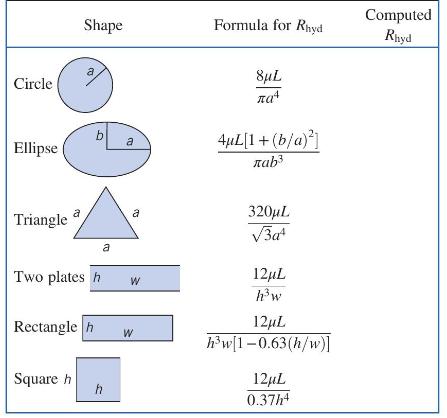For pressure-driven, steady, fully developed laminar flow of an incompressible fluid through a straight channel of length
Question:
For pressure-driven, steady, fully developed laminar flow of an incompressible fluid through a straight channel of length \(L\), we can define the hydraulic resistance as \(R_{\text {hyd }}=\Delta p / Q\), where \(\Delta p\) is the pressure drop and \(Q\) is the flow rate (analogous to the electrical resistance \(R_{\text {elec }}=\Delta V / I\), where \(\Delta V\) is the electrical potential drop and \(I\) is the electric current). The following table summarizes the hydraulic resistance of channels with different cross sectional shapes [30]:

Calculate the hydraulic resistance of a straight channel with the listed cross-sectional shapes using the following parameters for water flow: \(\mu=1 \mathrm{mPa} \cdot \mathrm{s}, L=10 \mathrm{~mm}, a=100 \mu \mathrm{m}, b=33 \mu \mathrm{m}, h=\) \(100 \mu \mathrm{m}\), and \(w=300 \mu \mathrm{m}\). Based on the calculated hydraulic resistance, which shape is the most energy efficient to pump water?
Step by Step Answer:

Fox And McDonald's Introduction To Fluid Mechanics
ISBN: 9781118912652
9th Edition
Authors: Philip J. Pritchard, John W. Mitchell





